Promote Printify, get paid!
Stay true to your followers and consumers by making them fully aware of your financial relationship with the products and services you promote. Write an affiliate link disclosure to be transparent about the commissions you earn for promoting affiliate products and earn the trust of existing and new audiences.
In this article, we’ll learn about the affiliate disclosure policy. What are affiliate disclosure statements, and how to write them? Plus, we’ll look at some examples of well-written affiliate link disclosures for some inspiration and guidance. Ready? Let’s get to it.
What is an affiliate link disclosure
In simple terms, affiliate link disclosure is a disclaimer. It’s a statement that lets buyers know that the site owner earns commissions for their clicks and purchases.
The Federal Trade Commission (FTC) mandated endorsement guides for affiliate marketers to ensure transparency and fair business practices. Follow the FTC guidelines and affiliate disclosure requirements to protect consumers and warn them about your sponsored content and affiliate links.
Why do you need an affiliate disclosure
Affiliate link disclosures form a clear relationship between website owners and site visitors in an honest, legal disclaimer. Avoid unethical business practices by warning your consumers that your promotions are part of affiliate marketing.
If buyers are fully aware of the financial relationship between the affiliate marketer and the product, they can make informed decisions on how much to support your endorsement. FTC requires affiliate link disclosures for content that’s honest and not misleading.
How to write an affiliate disclosure

Regarding affiliate disclosures, the FTC guidelines have a couple of requirements to keep in mind. Write a proper disclosure statement for your product endorsements to ensure consumer protection and transparency about your affiliate partnerships.
Let’s look at some key points any affiliate marketer should consider when writing a disclosure statement for their page.
Be clear, short, and simple with your language
Use clear and direct language in your affiliate link disclosures to ensure every reader understands it. Transparency and simple terms will form mutual respect. So avoid complex words and sentences that will confuse customers.
- Be direct. Get straight to the point and keep the affiliate disclosure short. A longer disclosure is only acceptable if you place a shorter one on each post, linking to the longer affiliate disclosure page. But don’t be overly lengthy.
- Avoid specific terms. Not all customers know what an affiliate program or link is. Don’t use words that only a specific niche might recognize. Explain your affiliate relationships in simple terms.
- Use trigger words. Immediately let your customers know about the affiliate relationship by highlighting words like commission or compensation in your affiliate disclosure text.
Format it right: Affiliate disclosure must be easily noticeable
Noticeability is an FTC requirement worth keeping in mind. This is where fonts, colors, and backgrounds come into play. Make sure your affiliate disclosure stands out on the website and matches affiliate disclosure guidelines.
The suggestions for this might seem vague, but they’re actually quite simple. Don’t overdo it, and don’t understate the look, positioning, and meaning behind the affiliate disclosure. What does that mean, exactly?
- Size. Don’t write the text in a tiny font that makes people squint and struggle to understand the message. But, also, don’t go overboard and exaggerate with the size. Stay in the middle – where it’s safe.
- Color. Keep the color somewhat mild – but still make it stand out from the rest of the page. Don’t use super bright fonts that are hard to read or colors too bland that will just blend in and disappear in the rest of the text.
- Background. If possible, change the background of the affiliate disclosure to make it stand out from the post or page. But nothing too bright that will – once again – be too hard to read and take in. Make it mild but noticeable.
Choosing the right placement
Placement is yet another legal requirement to keep in mind when adding affiliate link disclosures to a website. Don’t hide the affiliate links and disclosures in hard-to-reach places, on the very bottom, or somewhere no one will find them. Your readers won’t appreciate a game of “find the disclosure”.
FTC requires you to place affiliate disclosure statements as close to your affiliate links and promotions as possible. While this leaves many opportunities for placements, the best place to disclose your endorsements is above the fold (at the top of the page). You won’t find a more prominent spot than that.
Keep in mind users with mobile devices and tablets. Place the required disclosures accordingly and avoid legal clusters due to design flaws.
If you want to disclose the message on a separate affiliate disclosure page, make smaller announcements on every blog post, page, or profile. Those should state something like “This XX contains affiliate links. Click here for more information and a full affiliate disclosure statement” and direct readers to a separate page.
Use hashtags
The FTC released updates regarding affiliate disclosures and social media influencers in particular. If you have affiliate links or sponsorship deals, you must inform the audience about the affiliate relationships and endorsements on social media posts and platforms. But how?
It’s not easy to fit affiliate disclosures into reels, videos, small posts, or tweets. That’s where hashtags come in handy. Be as creative as you want, just make sure the hashtag explains to your audience that you’re getting compensated for your content.
However, affiliates should keep in mind some no-go hashtags that are considered misleading and inappropriate in certain circumstances. Here are some hashtag dos and don’ts to disclose your promotions adequately.
Do's:
- #sponsored, #paidad, #ad, #promotion, #collaboration
Dont's:
- #brandambassador, #affiliate, #productambassador, #ambassador
The affiliate disclosure hashtags can be placed anywhere in the caption, thumbnail, and pins as long as it’s not buried in a pile of other hashtags and texts. The FTC will not take excuses. Affiliates must always find space to disclose their partnerships and endorsements.
Use pre-built options
If you don’t have the time, will, or skills to write affiliate disclosures yourself, use services such as Termly – a free disclaimer generator. Or a pre-built WordPress plugin if you’re running a WP website.
Sites like Termly will create a disclosure for affiliates and their websites or mobile apps in just a few clicks. Log in with your email, answer a few questions about your partnerships and website, and add affiliate links. When all is done, let the generator do its job and create disclosure magic.
Place disclosures on your websites, posts, and pages, and excel in safe and transparent affiliate marketing.
8 Great affiliate disclosure examples
We’ve discussed all the technicalities and professional legal advice regarding affiliate links and disclosures. Now it’s time to look at some affiliates who have done it right.
We’ve compiled a list of eight affiliate link disclosure examples. Let’s see how to disclose affiliate links and promotions properly.
1. Tech Radar
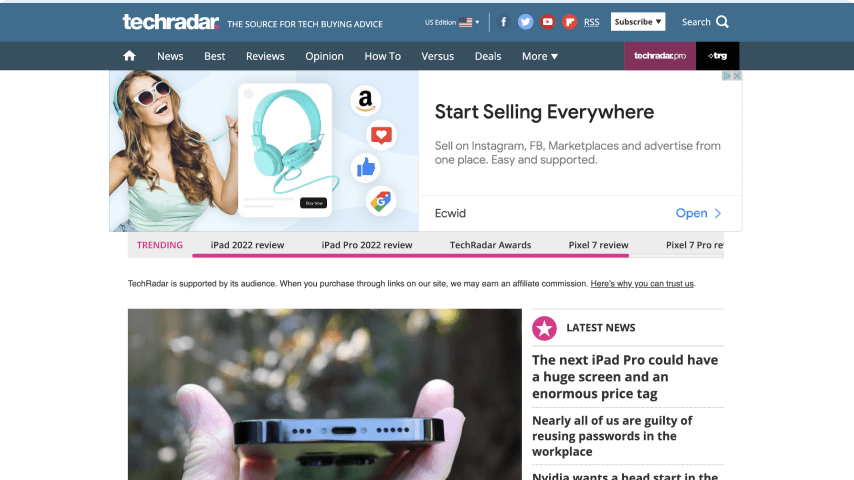
Tech Radar is a great example of affiliate disclosures. Their statement ticks every box in the guidelines, complying with everything we’ve described above.
The disclosure statement is on top of the website. It’s clear, simple, and easy to understand. It also provides a link to a separate page with more detailed information about endorsements and partnerships.
While there are no bright colors or different backgrounds, the text is separated from the rest of the page and easily noticeable the second you visit the site.
2. Young House Love
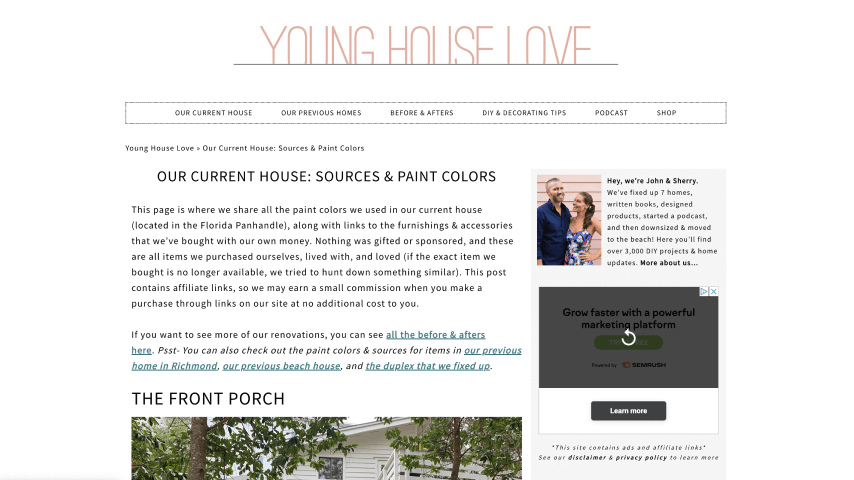
This is an excellent example of personal disclosures that include a bit of personality and quirkiness. While it states that the post is not sponsored or monetized in any way, it still includes an affiliate link or two, and they will earn small commissions with no additional costs to the buyers.
While it’s not the shortest disclosure statement, it’s honest, clear, fun to read, and easy to notice. It’s right at the top of the article, straight to the point, and easy to understand. Precisely what a disclosure should be.
3. Cookie and Kate
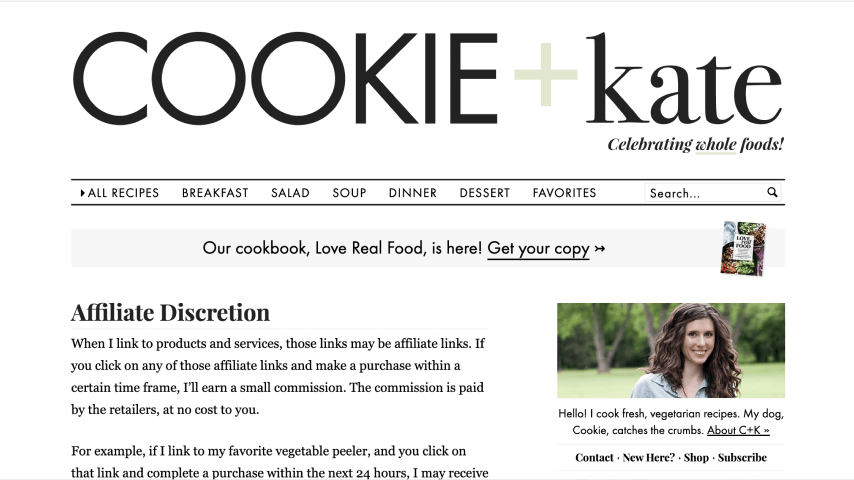
Kate and her dog Cookie ensure every website visitor knows their endorsements and can quickly identify affiliate links throughout the posts.
The affiliate discretion page (link found in the footer) provides all information necessary to explain commissions and earnings through affiliate programs and link sharing.
She also displays disclosures within the content whenever an affiliate link is posted. She uses clear and simple language in her statements, they are easily noticeable and explain the details of her partnerships.
4. Noelle Gallagher
When it comes to an FTC affiliate disclosure for YouTube, they strictly state two ways of disclosing sponsorships. The disclosure should be either posted visually at the beginning of the video or announced in it. And that is precisely what Noelle does.
Before starting her book reviews, she verbally announces that the video is being sponsored. This gives the viewers a clear and loud message about her endorsements and the products involved. Not only that, the description includes a link to the sponsored products or services.
Announcing the disclosure ensures that viewers are 100% informed about your affiliate deals and free products. Not everyone reads the description. Announcements are the way to go to ensure full transparency with your audience.
5. The Wirecutter
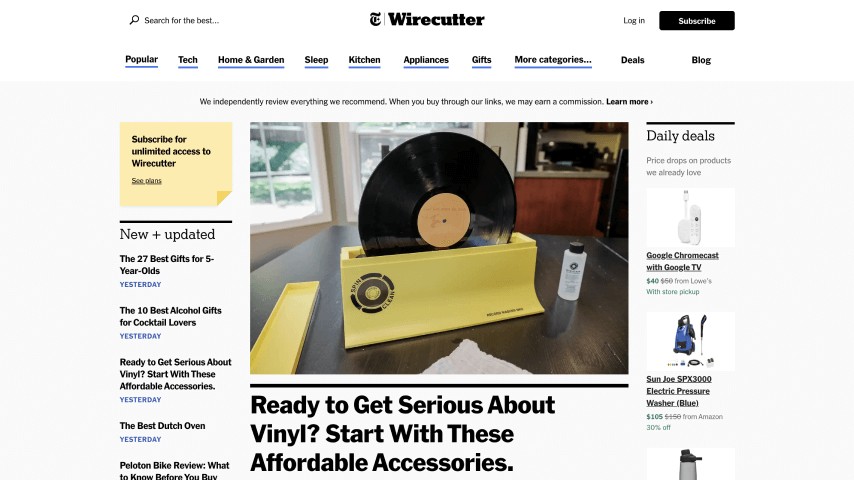
The Wirecutter is an excellent example of doing disclosure right. This big brand – owned by the New York Times – has listed its disclosure statement above the fold. On top of every article or section, it clearly states that they earn commissions when readers make purchases through their links.
Not only that, but a Learn More button leads you to a separate About Us page, explaining their affiliate deals and endorsements in detail. The customers can read about their objectivity, product selection, and overall morale there. While the main disclosure remains short, simple, and straight to the point.
6. Outside Magazine
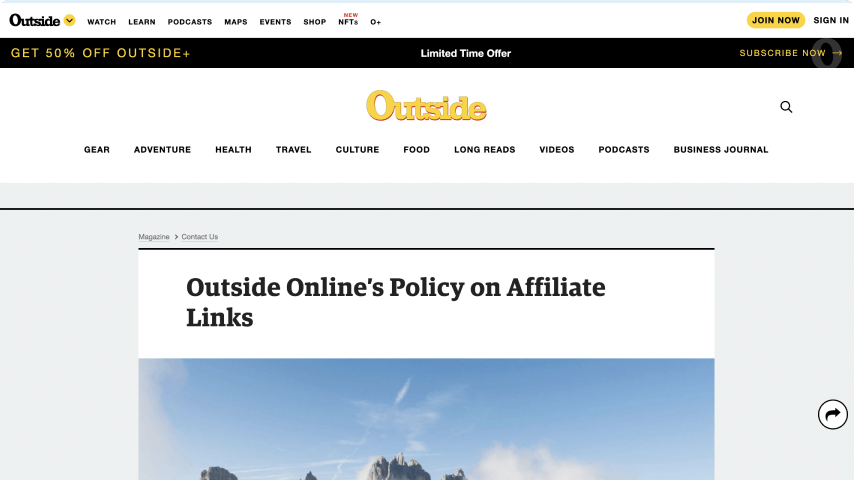
Outside Magazine is another great example of big brands doing affiliate marketing and disclosing it right. Their gear posts of featured merchandise have a clear, short disclosure at the bottom of the post, claiming they receive commissions from links.
And the official affiliate policy page goes into great detail and provides more in-depth information about endorsements and deals in general.
While putting a disclaimer at the very bottom is not the best option, it still works. And this is a good example of a large brand ensuring compliance with rules and requirements.
7. The Beauty Look Book
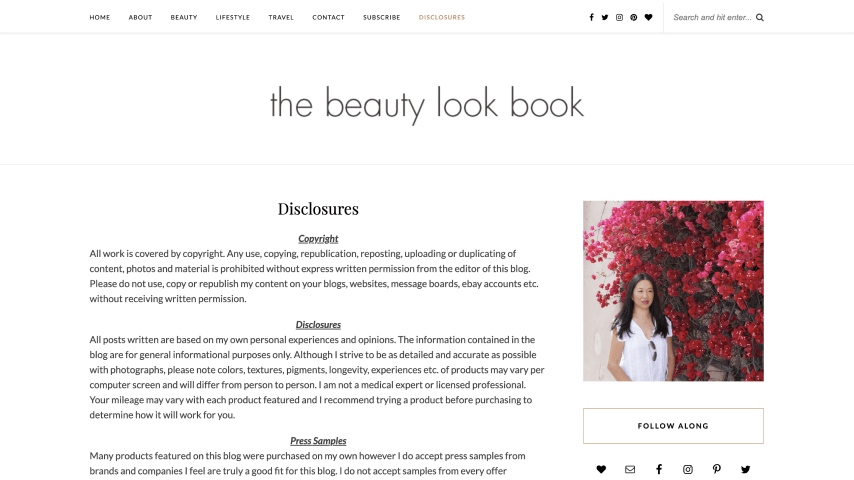
Sabrina, with her cosmetics review blog, is an excellent example of simple and easy-to-read disclosures. The blog features an FTC-compliant sidebar with an affiliate disclosure displayed in every blog post. This assures transparency throughout her entire content.
Not only that. She has also written a very thorough disclosure page that is very well-placed and easy to find, if we may add. The page covers everything from copyright to disclosures, sponsorship deals, and affiliate relationships. All in one place, simply written, straight to the point.
8. The Shop Files

This is another affiliate disclosure example of a statement done right. All affiliate disclosure requirements are met loud and clear within the website, informing users of existing affiliate links and endorsements.
The statement is written in clear and direct language, bringing attention to it with the “Heads Up”. It’s short, direct, and strategically placed to set it apart from the rest of the content.
Not only that. When it comes to affiliates and their promoted items, honesty is key to building trust and respect within the community. They only recommend tools they have personally tried. And admit getting a small commission through an affiliate link.
Frequently asked questions
Use affiliate disclosure generators or write your statements in clear and simple language. Make sure you’re direct and to the point, explaining to viewers that your website, blog post, or video contains affiliate links and that you get paid for clicks and conversions.
Possible placements include header, footer, sidebars, and other places. Keep in mind that you need to place disclosures as close to your affiliate links and promotions as possible. The best place for a disclosure is above the fold – on top of the page.
Use the WP affiliate disclosure plugin to create an FTC-compliant statement. Follow the guidelines, set your own rules, add text, an affiliate link, or HTML elements, and display the statement automatically across your website – before or/and after posts.
Is your affiliate disclosure ready?
Participate in affiliate marketing as a transparent and honest affiliate. Let your followers, readers, or customers know about the affiliate links beforehand and disclose the cooperation in a simple, honest way.
Don’t forget to join the Printify Affiliate marketing program to generate easy passive income and gain benefits as a Printify affiliate. Sign up, get your affiliate link, use these affiliate disclosure examples as a guide to write the perfect statement, and drive traffic to your website.
For any questions or assistance, contact the Printify Affiliate Manager via email – [email protected]. Get creative and succeed with Printify!












